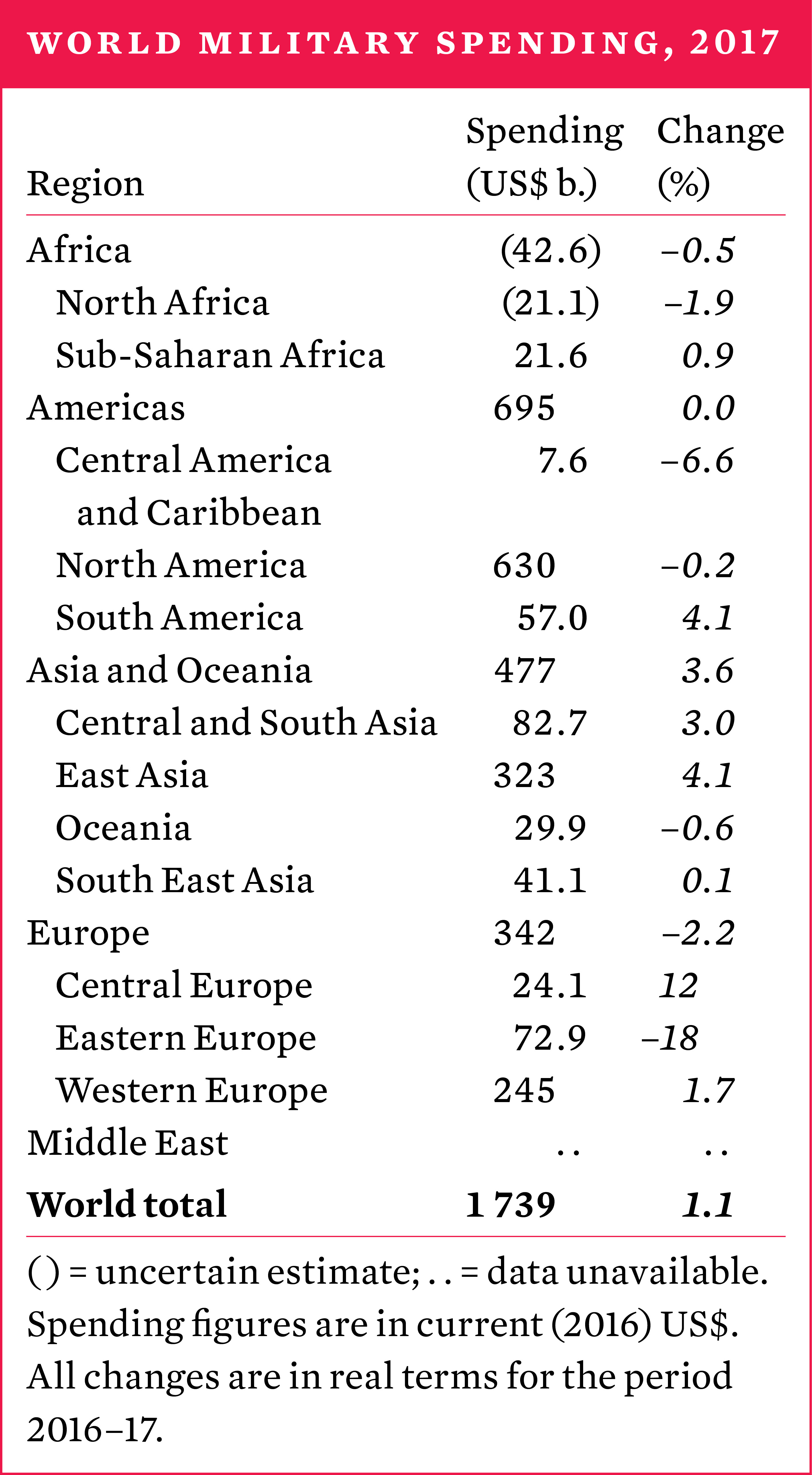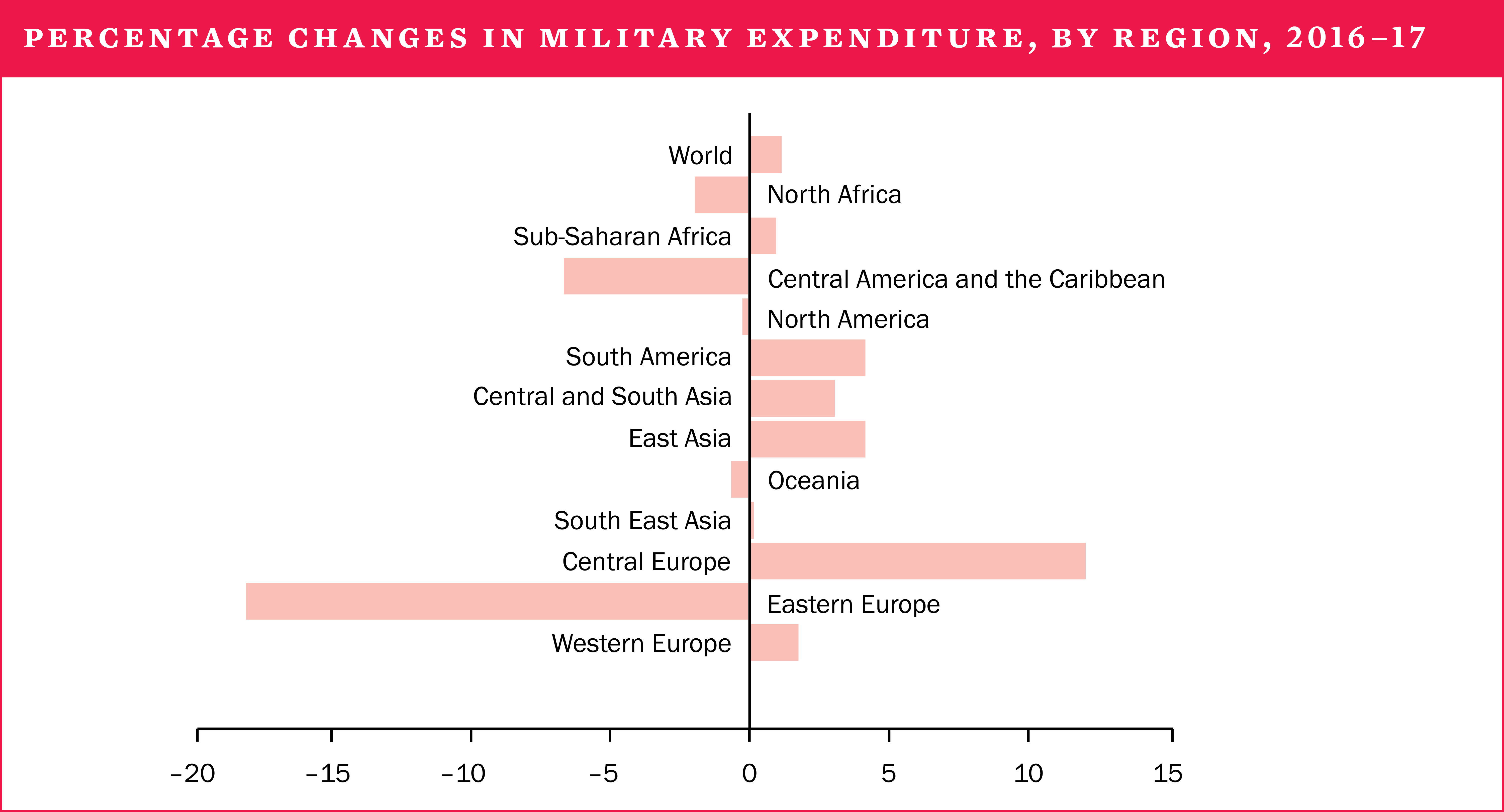4. Military expenditure
Overview, Nan Tian [PDF]
I. Global developments in military expenditure, Nan Tian, Aude Fleurant, Alexandra Kuimova, Pieter D. Wezeman and Siemon T. Wezeman [PDF]
II. Debt, oil price and military expenditure, Nan Tian and Diego Lopes da Silva [PDF]
III. Transparency in military expenditure, Nan Tian, Diego Lopes da Silva and Pieter D. Wezeman [PDF]
World military expenditure is estimated to have reached $1739 billion in 2017, the highest level since the end of the cold war, equivalent to 2.2 per cent of global gross domestic product (GDP) or $230 per person. Total global expenditure in 2017 was marginally higher compared with 2016, up by 1.1 per cent in real terms.
Military spending in North America fell for the seventh consecutive year, down by 0.2 per cent compared with 2016. By contrast, military expenditure in East Asia continued to rise, for the 23rd year in succession, and was up by 4.1 per cent compared with 2016. In Western Europe, spending increased for the third consecutive year, up by 1.7 per cent from 2016. There were mixed spending trends in the rest of the world: military spending decreased in Africa, Central America and the Caribbean, and Eastern Europe, while spending increased in Central Europe, the Middle East (based on the countries for which data is available) and South America.
At $610 billion, the United States remained the world’s largest spender, accounting for 3.1 per cent of its GDP, unchanged from the level in 2016. While US military expenditure in 2017 was 22 per cent below the peak reached in 2010, the trend of falling US spending has tapered off. In late 2017 the US Senate approved a new military budget for 2018 of $700 billion, a substantial increase over the 2017 budget.
China, the world’s second largest spender, allocated an estimated $228 billion to its military in 2017, an increase of 5.6 per cent compared with 2016—the lowest increase since 2010 but remaining in line with GDP growth plus inflation. Saudi Arabia became the third largest spender in 2017 following a 9.2 per cent increase in military expenditure to $69.4 billion. By contrast, Russia’s military spending fell by 20 per cent to $66.3 billion, making it the fourth largest spender in 2017. India, where spending rose by 5.5 per cent in 2017 to $63.9 billion, was the fifth largest spender.

Debt, oil price and military expenditure
For countries whose economies are dependent on the export of oil, the size of government oil revenues plays an important role in decisions on spending. The fall in the price of oil in 2014 (and low prices since then) has severely reduced oil revenues in these countries, leading to a need for alternative sources of finance (e.g. borrowing or debt) to fund spending, including military expenditure. An assessment of the trend in the price of oil compared with the trend in military spending and debt as a share of GDP for 15 oil export-dependent countries—Algeria, Angola, Azerbaijan, Ecuador, Iran, Iraq, Kazakhstan, Kuwait, Mexico, Nigeria, Norway, Russia, Saudi Arabia, South Sudan and Venezuela—showed that when oil revenue fell, alternative forms of finance were required and found. For these 15 countries, military expenditure between 2014 and 2017 decreased by an average of 16 per cent, but the price of oil dropped by over 45 per cent and the average increase in total debt as a share of GDP was around 154 per cent. The differences between revenue and expenditure in these countries have mostly been funded through debt.

Transparency in military expenditure
SIPRI made major steps in 2017 to improve transparency in military expenditure by mapping off-budget funding in Peru and Venezuela. Off-budget spending, which is not part of the state budget and is often non-transparent, is usually earned from natural resource exports. It may be used without the knowledge of the parliament or the finance ministry to pay for arms purchases and other activities. Off-budget funds offer lucrative opportunities for self-enrichment to public officials and businesses involved in the decision-making processes. In the cases of Venezuela and Peru, such funding amounted to billions of dollars of spending, often without accountability or oversight.
Military expenditure transparency at the international level remains a concern, specifically in the context of the United Nations Report on Military Expenditures. By 31 July 2017, at least 42 states had submitted a report to the UN on their military spending in 2016. No submission had been received from any state in Africa or the Middle East or from four of the five largest military spenders in the world: the USA, China, Saudi Arabia and India. Continued low participation in, and the lack of comprehensiveness of, the UN reporting mechanism puts into question its future viability.